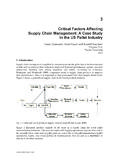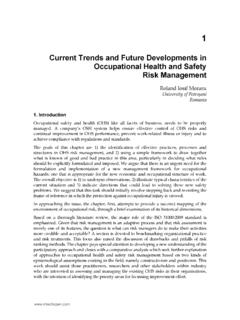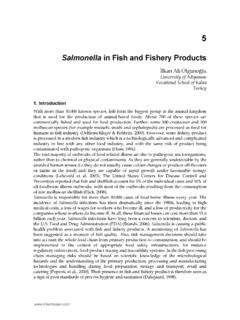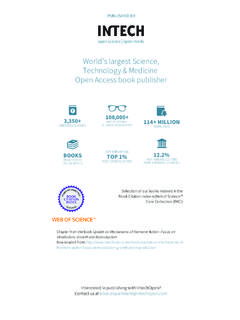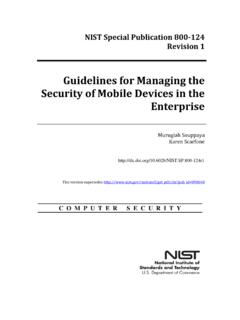Transcription of Supply Chain Management (SCM): Theory and Evolution
1 1 Supply Chain Management (SCM): Theory and Evolution Mamun Habib American International University - Bangladesh (AIUB) Bangladesh 1. Introduction During last decade, researchers usually focused on Supply Chain Management (SCM) issues in profit organizations. Research objectives may include adding value, reducing cost, or slashing response time in various parties involved in the manufacturing Supply Chain . However, very few studies were attempted in non-profit organizations. An extremely scarce number of research papers focused on SCM in the academia (Habib, 2011, 2010e, 2010d, 2010f, 2010g). Hay (1990) states that a profit organization attempts to maximize profits, whereas a non-profit organization considers monetary returns of less importance.
2 Their major objectives may include improved literacy rate, better quality of life, equal opportunities for all genders or races, etc. The revenues gained by a non-profit organization would be used primarily to balance the expenditure of the organization . Due to conflicting objectives, managing a successful profit organization may be drastically different from a non-profit organization (Firstenberg, 1996; Drucker, 1992). Recently, an increasingly large number of research studies highlight the criticalness of SCM as a means to assuring organizational success. SCM assists the business organization to compete in the dynamic international market. The objective of SCM is to incorporate activities across and within organizations for providing the customer value.
3 This should also be applicable to the academia, which represents a type of non-profit organizations. The goal is to provide the society value by producing high quality graduates and research outcomes. An integrated educational Supply Chain involves coordination and information sharing up and down the process among all stakeholders. With technology facilitating information flow, a coordinated Supply Chain can be designed to meet the strategic , planning, and operating objectives of the educational institutions. It also means establishing effective and feasible relationships both inside and outside the organization (Sandelands, 1994). SCM is needed for various reasons: improving operations, better outsourcing, increasing profits, enhancing customer satisfaction, generating quality outcomes, tackling competitive pressures, increasing globalization, increasing importance of E-commerce, and growing complexity of Supply chains (Stevenson, 2002).
4 Supply chains are relatively easy to define for manufacturing industries, where each participant in the Chain receives inputs from a set of suppliers, processes those inputs, and delivers them to a different set of customers. With Supply Chain Management - Applications and Simulations 4 educational institutions, one of the primary suppliers of process inputs is customers themselves, who provide their bodies, minds, belongings, or knowledge as inputs to the service processes (Habib and Jungthirapanich, 2009b, 2009c, 2010a, 2010c, 2010h, 2010i). This chapter reveals the following objectives: Analysis the overview of SCM through different citations. Review extensive literature reviews regarding SCM based on secondary data.
5 Define the SCM and the Evolution of SCM. Analysis the trends of SCM and its future perspectives. 2. Literature review The term, Supply Chain Management , has risen to eminence over the last ten years. About of the concurrent session titles contained the words Supply Chain at the 1995 Annual Conference of the Council of Logistics Management . The number of sessions containing the term rose to at the 1997 conference, just two years later. The term is commonly used to illustrate executive responsibilities in corporations (La Londe 1997). SCM has become such a hot topic that it is difficult to pick up a periodical on manufacturing, distribution, marketing, customer Management , or transportation without seeing any article about SCM or SCM-related topics (Ross, 1998).
6 Some authors defined SCM in operational terms involving the flow of materials and products, some viewed it as a Management philosophy, and some viewed it in terms of a Management process (Tyndall et al., 1998), some viewed it as integrated system. Authors have even conceptualized SCM differently within the same article: as a Management philosophy on the one hand, and as a form of integrated system between vertical integration and separate identities on the other hand (Cooper and Ellram, 1993). According to Christopher (1994), a Supply Chain is a network of organizations that are involved, through upstream and downstream linkages, in the different processes and activities that produce value in the form of products and services in the hands of the ultimate customer.
7 An example of a basic Supply Chain is shown in Figure 1. SupplierManufacturer Distributor Retailer CustomerFlow of goodsFlow of information and funds Fig. 1. The basic Supply Chain (Chopra and Meindl, 2001) The Supply Chain includes suppliers, manufacturers, distributors, retailers, and customers. The customers are the main focus of the Chain , since the primary purpose of the existence of any Supply Chain is to satisfy customer needs, in the process generating profit for itself (Chopra and Meindl, 2001). SCM was initially related to the inventory Management within a Supply Chain . This concept was later broadened to include Management of all functions Supply Chain Management (SCM): Theory and Evolution 5 within a Supply Chain .
8 According to Chopra and Meindl (2001), SCM engages the Management of flows between and among stages in a Supply Chain to minimize total cost . This definition implies that SCM involves Management of flows of products, information, and finance upstream and downstream in the Supply Chain . In the course of time, the most considerable benefits to businesses with advanced SCM capabilities will be radically improved customer responsiveness, developed customer service and satisfaction, increased flexibility for changing market conditions, improved customer retention and more effective marketing (Horvath, 2001). SCM is a concept, whose primary objective is to integrate and manage the sourcing, flow, and control of materials using a total systems perspective across multiple functions and multiple tiers of suppliers (Monczka, Trent and Handfield, 1994).
9 Stevens (1989) stated the objective of SCM was to synchronize the customers requirements with materials flow to strike a balance among conflicting goals of maximum customer service, minimum inventory Management , and low unit costs. The Supply Chain is viewed as a single process. Responsibility for the different divisions in the Chain is not fragmented and transferred to functional areas such as manufacturing, purchasing, distribution, and sales. SCM calls for, and in the end depends on, strategic decision-making. Supply is a shared objective of practically every function in the Chain and is of particular strategic importance because of its impact on overall costs, profits and market share.
10 SCM calls for a different point of view on inventories that are utilized as a balancing mechanism of last, not first, resort. A latest approach to systems is required - integration rather than interfacing (Houlihan, 1988). SCM is delivering major economic benefits to businesses as diverse as manufacturing, retail, and service organizations, etc. (Horvath, 2001). The scope of SCM was further expanded to include re-cycling (Baatz, 1995). SCM deals with the total flow of materials from suppliers through end users (Jones and Riley, 1985). It highlights total integration of all stakeholders within the Supply Chain , a realistic approach is to consider only strategic suppliers and customers since most Supply chains are too complex to attain full integration of all the Supply Chain entities (Tan et al.)




